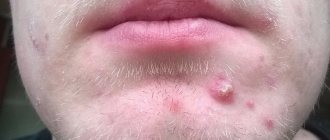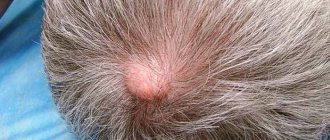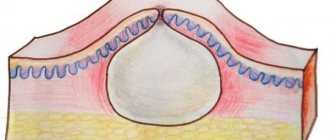Sweating (hyperhidrosis) is a natural physiological process characteristic of all warm-blooded living organisms. It performs a number of vital functions: regulates heat exchange and maintains optimal water-salt balance. But heavy sweating is a symptom of one of the dangerous diseases.
How and why sweat occurs
The content of the article
When overheated, sweat glands begin to release fluid to the surface of the skin, thereby reducing body temperature. Water-salt balance is needed to maintain a constant level of electrolytes and ions in the intracellular fluid. Blood plasma also has a salt composition, but in a slightly different concentration.
The main regulator of sweating is the hypothalamus, a region of the brain that sends signals to various parts of the endocrine system, in particular the sweat glands.
Thus, with an increase in the concentration of salts in the blood plasma and a decrease in the volume of intercellular fluid (workout, visiting a sauna, staying in the sun), the signal is processed by the hypothalamus, which reacts by creating a feeling of thirst.
When body temperature rises, regardless of whether it is external influence (overheating) or internal processes (fever), thermoreceptors reflexively react to this and signal the hypothalamus. It activates the work of more than 2.5 million sweat glands, and they begin to secrete sweat-fat secretion.
Botox injections
Botox has been used relatively recently to treat a condition called underarm hyperhidrosis. In our country, this method began to be used a little over ten years ago. Treatment of armpit hyperhidrosis with Botox is as follows: using a particularly thin needle, this substance is injected into the armpit area, which has a depressing effect on the activity of the sweat glands. If necessary, painkillers are used. The effect of this procedure lasts for six months. Then repeated injections are possible. After treatment, the patient is advised to avoid visiting the sauna, intense physical activity, and drinking alcohol for a while.
What kind of sweating is considered normal: norms, smell
Normally, even at rest, women secrete about 500 ml. sweat, in men - 700-1000 ml. During illness, when body temperature rises, about 3000 ml of sweat is produced per day. Such losses must be compensated, otherwise unpleasant consequences will arise - dehydration.
In addition to reactions to temperature, sweating is psychogenic in nature. Thus, apocrine glands located in the armpits, groin, and genital area are activated at the moment of emotional arousal, when an object of the opposite sex appears, during a quarrel or an increase in the emotional and mental background
The composition of the sweat from these glands is more concentrated, it contains enzymes that have a strong odor. However, it does not cause rejection, but carries genetic information. These are so-called pheromones, which help to choose a person who is suitable from a genetic point of view.
The unpleasant odor of sweat is due to the fact that the sweat of the subcutaneous sweat glands, eccrine glands, can destroy the keratin that covers the top layer of the skin. Microorganisms living on the epidermis begin to feed on softened keratin and multiply, releasing decay products. This is what causes the unpleasant odor.
It is especially active in the area of apocrine glands, so it is important to maintain hygiene standards. Usually, taking a shower or using wet wipes solves the problem of excessive sweating, but in some cases, hyperhidrosis becomes pathological and indicates serious problems in the body.
What does increased sweating indicate?
Hyperhidrosis is not always a pathology. Sweating affects obese and overweight people, women in the premenopausal period, and teenagers. There is nothing abnormal about this. Men sweat 2 times more intensely than women, people with African roots have a genetic predisposition to hyperhidrosis, and in summer the intensity of sweating increases regardless of gender and age.
Professional athletes who train 5-6 hours a day, even after taking a shower and completely changing clothes, continue to sweat intensely for some time after physical activity, and this is not a deviation from the norm.
Some people don’t see anything wrong with sweating; it doesn’t irritate them, although those around them suffer from it.
We should talk about pathology when the problem not only interferes with the person who has it, but also affects social connections. Sweat has a rather complex composition, which includes lactic and uric acids, ammonia, and various salts. As a result of exposure to the epidermis, bacteria are activated, which feed on softened keratin particles. This is precisely the reason for the specific vinegar smell of sweat.
In principle, it is enough for a healthy person to regularly change his underwear and take a shower daily so that the unpleasant smell of sweat is not heard. Apocrine glands secrete a substance with an individual odor depending on health, age and fertility.
In unhealthy people, it becomes intense and repulsive to others. Moreover, standard preventive measures (changing underwear, using antiperspirants, showering twice a day) do not bring any results.
Sweating for no apparent reason indicates pathological processes in the body, among which there are life-threatening pathologies. In particular, hyperhidrosis is characteristic of impaired hemostasis - the optimal level of hormones. This happens when there is a malfunction of the hypothalamus, a small area of the brain that controls the endocrine system.
The most famous example of disturbances in the functioning of the hypothalamus is menopause - the attenuation of a woman’s reproductive functions. During this period, the hypothalamus sends incorrect signals, the endocrine systems experience disruption and react with involuntary activation of the sweat glands - the so-called hot flashes.
In addition to menopause, hyperhidrosis occurs in case of other disorders.
Increased sweating in thyroid diseases
Sweating is characteristic of hyperthyroidism, characterized by an increase in the production of thyroid hormones and the development of intoxication.
In addition to increased, causeless sweating, symptoms of hyperthyroidism include:
- sudden weight loss
- drowsiness
- swelling in the neck area
- tachycardia
- irritability and nervousness
- diabetes. Under the influence of sugar in the blood, blood vessels and nerve connections are destroyed, but not throughout the body, but only in certain areas. The scalp, arms, neck and chest sweat especially heavily in diabetes.
Sweating is also characteristic of hypoglycemia - a lack of glucose in the blood. This is caused by an increase in adrenaline levels, which is activated when there is a lack of sugar.
Treatment
Help before diagnosis
To reduce the discomfort from increased sweating, it is necessary to observe hygiene standards and avoid wearing hats made of synthetic materials. It is advisable to exclude hot and spicy foods and alcohol from the diet, which often increase sweating. To eliminate symptoms during public speaking, you can use sedatives of herbal origin. In case of local cranial hyperhidrosis, you should consult a specialist to identify the cause of unpleasant manifestations and choose the optimal treatment tactics.
Treatment of scalp hyperhidrosis with botulinum toxin
Conservative therapy
If the disease that causes excessive sweating is determined, the symptoms disappear after the cause is eliminated. In the acute period of injuries and neurological diseases, therapy is aimed at correcting vital functions and restoring the functional capabilities of the body, and the elimination of increased sweating is carried out by symptomatic means. When sweating is combined with erythrophobia, psychotherapeutic methods are effective. For the medical treatment of scalp hyperhidrosis, the following pharmaceuticals are used:
- Anticholinergics
. Drugs from the atropine group selectively inhibit the activity of neurons of the sympathetic nervous system, due to which sweat production decreases. Medicines are taken orally or administered intravenously. - Sedatives
. For moderate hyperhidrosis, herbal and synthetic sedatives are effective. If your scalp sweats a lot, you may need light “daytime” tranquilizers that do not affect performance. - Local agents
. Use rubbing the skin with aluminum chloride hexahydrate, which is diluted in alcohol. In some patients, local iontophoresis with saline solutions and anticholinergics is effective. - Antiparkinsonian drugs
. For increased sweating caused by Parkinson's disease, specific medications are prescribed that affect the metabolism of dopamine in the brain. Treatment is carried out in long courses. - Antihypertensive drugs
. To quickly relieve a hypertensive crisis, loop diuretics and beta-blockers are administered. In the future, an individual treatment regimen for hypertension is selected to prevent exacerbations. - Botulinum toxin
. If other drug methods are ineffective, intradermal administration of the drug is recommended. The drug allows you to reduce the number of nerve impulses entering the sweat glands, and thereby reduce sweating.
Surgery
Hyperhidrosis of the head and face, refractory to conservative treatment measures, requires surgical interventions. Most often they resort to endoscopic sympathectomy (destruction or clipping of the sympathetic trunk), which is aimed at reducing the functional activity of the sweat glands. To eliminate the consequences of severe TBI as the leading cause of hyperhidrosis, removal of intracranial hematomas for decompression of brain structures is indicated, and, if necessary, repositioning of bone fragments is carried out.
Pheochromocytoma - sweating due to adrenal tumors
Pheochromocytoma is a tumor of the adrenal gland that stimulates the production of catecholamines - adrenaline and norepinephrine. The disease is characterized by crises, during which panic attacks, tachycardia, nausea, gag reflex, and increased sweating are observed.
The attack is impossible not to notice, because it is accompanied by impaired cerebral circulation, trembling in the body and pulmonary edema. It lasts 2-3 minutes, but is extremely stressful for a person.
In the absence of an adrenal tumor, an increase in catecholamines is caused by heart disease, alcohol withdrawal, and refusal to take certain medications.
Ovarian dysfunction
The pathology occurs in every 10th woman of reproductive age. This may be an ovarian cyst, but polycystic disease often occurs - a complex disease in which ovulation does not occur and the follicle begins to grow. Over time, the ovary becomes like a bunch of grapes due to the many cysts that form.
Hormonal imbalance and lack of female sex hormones lead to increased production of testosterone, the male sex hormone. It increases metabolism, causing increased sweating.
It is also promoted by autonomic disorders, accompanied by irritability, aggressiveness, and sleep disorders. Symptoms of ovarian dysfunction, in addition to sweating, are menstrual irregularities, weight changes, deterioration in health, increased hair growth, etc.
Sweating and central nervous system diseases
The autonomic nervous system is controlled by centers in the medulla oblongata and spinal cord, and the center is located in the hypothalamus. Ganglia, sympathetic nerve ganglia, are located near the spine, and nerve impulses emanating from them travel along nerve fibers to various parts of the body. If there is a disturbance in the functioning of the central nervous system, increased sweating occurs, regardless of the cause of the malfunction.
But this is only a secondary sign, indicating more significant symptoms:
- with Parkinson's disease,
a person's hands and head shake, muscles have increased tone, and their gait changes; - a stroke
is characterized by speech impairment, changes in facial expressions, and severe headache; - with epilepsy,
a person experiences convulsive seizures, during which hyperhidrosis occurs due to severe overexertion; - with a concussion,
loss of consciousness, nausea, and perspiration may appear on the forehead; - injury to the hypothalamus
manifests itself not only by increased sweating, but also by pressure surges, vascular problems, and sleep disturbances; - hormonal changes.
Teenagers tend to sweat a lot. This is due to a sharp hormonal surge, as well as intensive development of the whole organism and an increase in the functioning of most glands. There is nothing pathological about this, but sweating can cause discomfort for a teenager.
Causes of sweating
Causes of cold sweat
Increased sweating is often accompanied by a sharp cold snap and pale skin. A similar reaction normally occurs during severe emotional shocks, but more often the appearance of cold sweat is caused by pathological conditions:
- Migraine
. - Severe pain syndrome
. - Viral infections
: mononucleosis, influenza. - Critical conditions
: hypoglycemia, acute cardiac or respiratory failure. - Autonomic regulation disorders
. - Intoxication
: alcohol abuse, formation of endogenous toxins in renal and liver failure.
Causes of general sweating
Excessive sweating over the entire skin is a normal reaction in hot climates, after intense physical activity. Persistent hyperhidrosis with no apparent cause is a sign of illness. Increased general sweating is caused by:
- Endocrine diseases
: thyrotoxicosis, menopause in women, pheochromocytoma, etc. - Infectious processes
: brucellosis, malaria, HIV infection. - Oncological pathology
: lymphogranulomatosis, non-Hodgkin's lymphoma, neoplastic syndrome. - Poisoning
: consumption of poisonous mushrooms, ingestion of organophosphorus compounds. - Complications of pharmacotherapy
: long-term use of cholinomimetics, anticholinesterase drugs. - Rare causes
: Riley-Day syndrome, Cassirer's acroasphyxia, polyneuropathy.
Causes of sweating head
Severe sweating in the face and scalp, accompanied by hot flashes or, conversely, severe pallor and coldness, develops in the presence of painful disorders. Local sweating of the head is caused by:
- Nightmares, sleep disturbances
. - VSD
: increased activity of the sympathetic nervous system. - Neurological disorders
: Parkinson's disease, neurosyphilis, stroke. - Hypertensive crises
. - Damage to the nerve trunks
: chorda tympani syndrome, Lucy Frey auricotemporal syndrome. - Genetic diseases
: Beech, Jadasson-Lewandowski, Hamstorp-Wohlfahrt syndromes.
Causes of night sweats in women
Women are more susceptible to various pathological reactions of the autonomic nervous system and hormonal imbalances, so hyperhidrosis is more common in them. Excessive night sweats in women can be caused by the following diseases and conditions:
- Hormonal changes
: a few days before menstruation, in the first trimester of pregnancy, in the premenopausal period. - Neuropsychic pathology
: multiple sclerosis, psychosis, depressive states. - Systemic connective tissue diseases
: rheumatoid arthritis, lupus erythematosus, rheumatism. - Complications of pharmacotherapy
: taking tranquilizers, antipsychotics, antihypertensive drugs.
Causes of night sweats in men
Normally, sweating increases at high temperatures in the bedroom when using synthetic bedding. Unreasonable release of large amounts of sweat, causing the pillow and sheets to get wet, indicates the possible presence of a pathological process. In men, night sweats are most often caused by conditions such as:
- Withdrawal syndrome:
with abuse of alcoholic beverages and narcotic substances. - Hormonal imbalances
: in adolescence, middle and old age due to decreased testosterone levels. - Endocrine diseases
: carcinoid syndrome, pheochromocytoma, damage to the hypothalamic-pituitary system. - Tuberculosis infection.
- Tumor
and: testicular cancer, prostate cancer. - Rare causes
: sarcoidosis, histiocytosis.
Reasons for decreased sweating
A decrease in the secretion of sweat glands (anhidrosis), which occurs against the background of normal health, is observed in older people due to natural age-related changes in the skin. Sweat production is noticeably reduced in the following conditions and diseases:
- Severe dehydration:
with limited water intake, repeated vomiting and diarrhea. - Skin lesions
: atrophic acrodermatitis, radiation dermatitis, scleroderma. - Hereditary pathologies
: Sjogren's disease, ectodermal dysplasia. - Complications of pharmacotherapy
: treatment with antiepileptic drugs, ganglio- and anticholinergic blockers.
Sweating during menopause and pregnancy
In women before menopause, the levels of progesterone and estrogen decrease and the amount of FSH increases. This is a rather long process; menopause does not occur in one day. Several years before the onset of hormonal changes, a woman feels changes at the physiological level: her body odor changes, she sweats more often, quickly gains weight and has difficulty losing it.
Gradually, the level of female sex hormones falls, and male sex hormones (androgens) are produced more than during the fertile period.
Sweating is not the biggest problem; it only indicates irreversible changes in the body. If a woman notices an unusual increase in sweating, she should contact an endocrinologist. The doctor will conduct all the necessary tests and prescribe hormone replacement therapy.
Also, increased sweating often occurs in pregnant women, especially in the 1st trimester. The reason is a sharp restructuring in the body caused by implantation of the embryo to the wall of the uterus. The hypothalamus actively stimulates the production of progesterone, while other hormones are produced in smaller volumes.
A characteristic feature is sweating of the feet, regardless of the intensity of physical activity or its absence. At the same time, in other parts of the body, dehydration and dry skin occurs, even to the point of peeling. This is not a pathology, and by the 2nd trimester, local hyperhidrosis appears much less pronounced.
Iontophoresis
The procedure involves introducing special substances into the body using galvanic current. To treat sweating, water with the addition of various medications is used. Hyperhidrosis of the armpits is eliminated in this way less effectively than excessive sweating of the feet or palms. As a rule, 5-10 sessions are enough. In the future, if necessary, maintenance procedures are carried out. Iontophoresis can be combined with other treatment methods. Despite the fact that this procedure is simple and safe, it is contraindicated during pregnancy, epilepsy, neoplasms, and in the presence of implants.
Cardiovascular disease and sweat
They are also characterized by hyperhidrosis caused by activation of the central nervous system. Other symptoms, depending on the disease, include the following:
- for hypertension: increased blood pressure, increased heart rate, tinnitus, headaches, numbness of the hands;
- with coronary heart disease: pain behind the sternum (angina pectoris), inability to take a full breath, nausea and very profuse sweating;
- during myocardial infarction, perspiration covers the entire body, a feeling of fear arises, blood pressure drops, and the person feels very severe pain in the heart area;
- hyperhidrosis with thrombophlebitis occurs in advanced forms of blockage of the vein lumen;
- tachycardia occurs as a reaction to stress or fear, while a person’s adrenaline level increases, the body becomes covered in perspiration, and it becomes difficult to breathe. With tachycardia, there is heat in the head, but the hands remain cold;
- with vegetative-vascular dystonia, sweating is a reaction to stress, even the slightest one.
But with this pathology, the body mobilizes regardless of the reality of the situation. Often a person suffering from VSD experiences bouts of sweating and panic attacks completely unexpectedly: in the subway, in a crowd or in a quiet environment. In this case, hyperhidrosis is a side reaction to imaginary or real stress.
Facial hyperhidrosis - signs
This disease causes a lot of trouble to its owner, because the face is the first thing that people around you and interlocutors pay attention to. And if your face becomes covered with sweat at the slightest excitement, then everyone notices it.
The patient is in a state of permanent stress, especially if the nervous system is weak. Girls and women suffer more than men, because facial beauty is the first thing every woman worries about.
It turns out to be a vicious circle - the face becomes covered with sweat at the slightest excitement or before a public speech, and the performance itself turns into a source of extreme stress, which causes even more profuse sweating.
Thus, for patients with facial hyperhidrosis, some public professions may be inaccessible: artist, politician, teacher, television announcer, journalist. A person suffering from this disease tries to appear in society less often, often withdraws into himself and even changes his profession. Often craniofacial hyperhidrosis is combined with erythrophobia (painful redness of the face). And if a girl blushes cutely in some situations, young people even like it. But when the face turns crimson and sweat rolls off it, there is no time for coquetry, and only a doctor can help in this situation.
Sweating due to infection
The vital activity of viruses and bacteria is accompanied by the production of pyrogens that affect the thermal sensitivity of neurons. During the period of exacerbation of an infectious disease, body temperature always rises significantly, which is why hyperhidrosis occurs. The virus is accompanied by muscle pain and body aches, the bacterial infection is accompanied by a skin rash and general toxicity.
Rheumatism is also infectious in nature. The patient's body temperature is constantly elevated, which causes severe sweating. Damage to joints and connective tissue prevents normal movement, but people sweat as if after intense training.
Syphilis is a sexually transmitted disease that affects the mucous membranes. It is characterized by damage to the nerve roots located along the spine, which is expressed by a local increase in sweating.
Malignant and benign tumors
The center of thermoregulation is the hypothalamus, and tumors of any nature in this area cause hyperhidrosis. Sweating especially increases at night, regardless of the temperature in the room.
If this happens without explanation, then the following diseases can be assumed:
- histiocytic lymphoma (malignant lesion of lymphoid tissues);
- lymphocytic lymphoma (oncological damage to the lymph nodes);
- mixed lymphoma (complex cancer of the lymph nodes);
- Burkitt's lymphoma (malignant tumor of the jaw).
Oncological neoplasms are accompanied not only by hyperhidrosis, but also by sudden weight loss, sleep disturbances, general weakness and fatigue.
What research is being done to identify the true causes of hyperhidrosis?
Excessive sweating is a subjective concept. Not everyone is alarmed by hyperhidrosis, so we need to talk about pathology if increased sweating is not typical for a person, causes him severe discomfort and causes anxiety.
The initial examination is carried out by an endocrinologist or therapist, because in most cases the cause of excessive sweating is a disruption in the functioning of the endocrine system. The specialist gives a referral for standard tests showing the general condition of the patient’s body.
These include:
- general blood analysis;
- general urine analysis;
- blood chemistry;
- analysis of thyroid hormones (T3, T4, TSH);
- ECG.
Depending on the test results, the patient undergoes additional examinations.
Pharmacy remedies for hyperhidrosis
Pharmacy products include various ointments and special deodorants.
The main components of such drugs are:
- zinc,
- salicylic acid,
- aluminum chloride.
Teymurov and Lassar pastes cope well with excessive sweating. They have an antiseptic effect. They are applied to cleansed skin in the problem area. They keep the skin dry, absorb excess moisture and reduce the activity of sweat glands.
Doctors also often prescribe Urotropin in ampoules for excessive sweating. Using a cotton pad, apply it to problem areas and leave overnight. In the morning, wash off the product.
Formagel works in the same way.
Attention! Pharmacy sedatives may be prescribed. They are necessary to maintain a stable state of the nervous system.
Description of tests and ultrasounds prescribed for excessive sweating
| Preliminary diagnosis | Research | What is the essence of the study? |
| Suspicion of cancer | Analysis for tumor markers | Analysis for tumor markers Tumor markers are specific proteins, the concentration of which increases in the body only during oncological processes. In healthy people, tumor markers are contained in minimal quantities. The main tumor markers are: PSA is a protein that concentrates in a man’s blood during the development of prostate cancer. An increase in protein also occurs with adenoma (benign tumor) of the prostate gland. HCG is present in the body of both women and men. It increases significantly during pregnancy, so it is additionally taken along with a blood test for alpha-fetoprotein (AFP). When the concentration of both proteins increases, a preliminary diagnosis of testicular cancer is made, and in women with ovarian cancer, the AFP level increases significantly. Also, an increase in hCG is observed in cancer of the stomach, uterus, intestines, liver, as well as uterine fibroids. AFP - increases in oncological processes, especially in the liver, as well as in cirrhosis, hepatitis and renal failure. In a pregnant woman, it indicates fetal pathology. Ca-125 is a tumor marker that helps identify cancer of the uterus, breast, stomach, liver, pancreas, etc. It also increases with endometriosis, ovarian cysts, and peritonitis. |
| Suspicion of a pituitary tumor | MRI and angiography Analysis for prolactin X-ray with an eye to the sella turcica Analysis of cerebrospinal fluid (CSF) | For pituitary tumors, a combined MRI and angiography technique is used - studying cerebral circulation. The technique allows you to detect tumors as small as 5 mm. Prolactin is a pituitary hormone that is responsible for milk production in women, but is also present in men. It increases with uterine fibroids, pregnancy, ovarian tumors, and pituitary tumors. Breast discharge in men is associated with an increase in prolactin, which reduces the concentration of male sex hormones and increases the levels of estrogen and progesterone. A pituitary adenoma is indicated by a prolactin concentration in the blood of more than 250 ng/l. The sella turcica is a bone formation in the bed of which the pituitary gland is located. When the walls of the sella turcica are deformed, one can judge the growth of a pituitary tumor. The only drawback is that bone deformation occurs only when the tumor is large. When identifying pituitary tumors, myelin basic protein (MBP) is of great importance. In a healthy person, its value does not exceed 4 mg/l. Also, with neoplasms, epithelial cells are detected in the cerebrospinal fluid, which should not normally be present. The analysis does not yet confirm pituitary adenoma, but is an indication for a more in-depth study. |
| Suspicion of diabetes mellitus | Blood and cerebrospinal fluid test for glucose | A feature of hyperhidrosis in diabetes mellitus is excessive sweating in the armpits, palms, neck, but dry skin of the legs and feet. A blood test will quickly indicate an increase in blood sugar. with an increased glucose content in the cerebrospinal fluid, we can talk about viral lesions of the brain (meningitis). |
| Menopausal syndrome | Sex hormone analysis | “Hot flashes” shortly before the onset of menopause are associated with a decrease in the level of female sex hormones and an increase in androgens. Determining the ratio of estrogen, progesterone, LH and FSH shows a complete picture of hormonal levels. |
| Suspicion of tuberculosis | PCR diagnostics | Polymerase chain reaction helps identify Koch's bacillus within 4 hours. Unlike Mantoux, PCR detects even one bacilli of the pathogen at the earliest stage of the disease. The analysis will also help to select an effective drug and identify resistance to certain drugs. |
| Suspicion of infection | Linked immunosorbent assay | ELISA allows you to see the connection between the body’s immune cell and the cell of the infectious agent. Depending on the type of immunoglobulin (IgE, IgD, IgG, IgM, IgA), the type of pathogen is identified. The analysis identifies more than 600 infectious agents and viruses. |
| Suspicion of heart disease | Laboratory blood test | ESR increases with endocarditis, rheumatic heart disease. In chronic heart failure, the level of protein, as well as potassium and sodium in the blood serum increases. High cholesterol indicates atherosclerotic vascular disease. An increase in white blood cells indicates inflammation. A large number of platelets is observed with venous thrombosis. Enzymes ALT and AST increase during myocardial infarction. An increase in electrolytes occurs when the heart rhythm is abnormal. C-reactive protein is concentrated during myocardial infarction. |
| Suspicion of pheochromocytoma | Ultrasound of the abdominal organs | Pheochromocytoma is a tumor of the adrenal glands that leads to hormonal imbalance. The tumor is visualized on ultrasound as an oval or round formation of increased echogenicity. |
| Suspicion of acromegaly | Analysis for somatotropin | Somatotropic hormone (GH) affects not only growth, but also overall metabolism. A high concentration of the hormone indicates a tumor of the pituitary gland, stomach or lungs, anorexia nervosa, cirrhosis of the liver, and renal failure. Sometimes an illiterate diet leads to an increase in growth hormone, leading to depletion of the body. Low levels of growth hormone indicate pituitary insufficiency caused by infectious lesions of the brain, autoimmune pathologies, vascular disorders and postpartum blood loss. |
Diagnostics
The primary diagnostic search for excessive sweating is carried out by a general practitioner or general practitioner. The main objective of the examination is to identify disturbances in the functioning of the body that provoked changes in the functioning of the sweat glands. For this purpose, special functional tests, laboratory tests and instrumental visualization methods are prescribed. The most valuable for diagnosis are:
- Quantitative and qualitative tests
. To determine the degree of excessive sweating, a gravimetric method is useful, which involves weighing a piece of filter paper after 1 minute of contact with the skin. To measure the area of hyperhidrosis, the Minor test is used. Verification of the primary form of increased sweating is carried out using the chromatographic method. - Laboratory research
. The levels of the main hormones are measured - corticosteroids, thyroxine, tropic substances of the pituitary gland. Women must be tested for estrogen and progesterone levels. To exclude diabetes mellitus, fasting glycemia is determined, and a glucose load test is prescribed according to indications. Blood tests look for signs of inflammatory and tumor processes. - Neurological examination
. The appearance of increased sweating is often associated with pathologies of the nervous system, so all patients are examined by a neurologist. In addition to physical examination and assessment of basic reflexes, EEG and ultrasonography of peripheral nerves are used. According to indications, CT and MRI of the brain are prescribed.
When organizing further examination, accompanying symptoms are taken into account: in case of signs of an infectious process, serological tests are performed; in autoimmune diseases, the levels of rheumatoid factor and other specific markers are measured. Some patients are recommended to undergo a psychiatric evaluation. To diagnose doubtful cases of excessive sweating, consult other specialists (dermatologist, infectious disease specialist, oncologist).
Antiperspirants reduce sweat production and neutralize unpleasant odors
conclusions
Excessive sweating, not associated with increased physical activity, is a common sign of serious pathologies in the body. if this condition persists for a long time or often recurs, you need to urgently consult a doctor - a gynecologist, urologist, andrologist or endocrinologist, get tested and undergo an expert ultrasound.
If you find an error, please select a piece of text and press Ctrl+Enter











